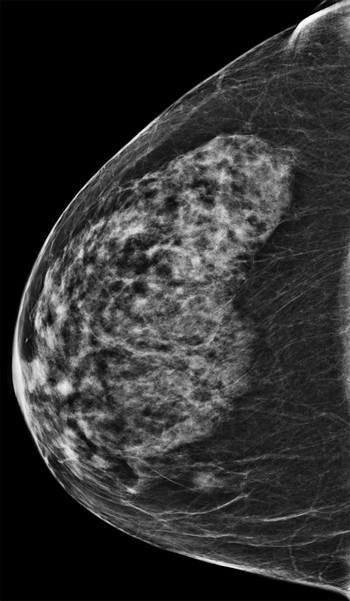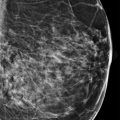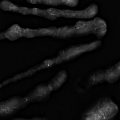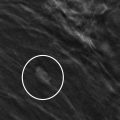Presentation and Presenting Images
( ▶ Fig. 44.1, ▶ Fig. 44.2, ▶ Fig. 44.3, ▶ Fig. 44.4)
A 70-year-old female presents for screening mammography. Her mother had postmenopausal breast cancer.
44.2 Key Images
44.2.1 Breast Tissue Density
The breasts are heterogeneously dense, which may obscure small masses.
44.2.2 Imaging Findings
In the lower inner quadrant of the right breast in the middle depth, there is a focal asymmetry. In comparison to the prior mammograms ( ▶ Fig. 44.3 and ▶ Fig. 44.4), this could also be referred to as a developing asymmetry. The tomosynthesis images help to localize this lesion to the lower inner quadrant and support that this lesion is real and not overlapping fibroglandular tissue ( ▶ Fig. 44.5 and ▶ Fig. 44.6). This lesion is less apparent on the conventional mammographic mediolateral oblique (MLO) image ( ▶ Fig. 44.2) but well seen on the craniocaudal (CC) image ( ▶ Fig. 44.1).
44.3 BI-RADS Classification and Action
Category 0: Mammography: Incomplete. Need additional imaging evaluation and/or prior mammograms for comparison.
44.4 Diagnostic Images
( ▶ Fig. 44.7, ▶ Fig. 44.8, ▶ Fig. 44.9, ▶ Fig. 44.10, ▶ Fig. 44.11, ▶ Fig. 44.12, ▶ Fig. 44.13)
44.4.1 Imaging Findings
The diagnostic imaging better defines this focal asymmetry as an 8-mm oval even-density mass with spiculated margins at the 4 o’clock location in the middle depth ( ▶ Fig. 44.7 and ▶ Fig. 44.8). The spot-compression images displace the adjacent tissues with this mass located at the periphery of the breast tissue. The targeted ultrasound reveals a 7 × 5 × 8 mm oval hypoechoic mass with angular and indistinct margins at the 4 o’clock location, 4 cm from the nipple ( ▶ Fig. 44.10 and ▶ Fig. 44.11). Normal lymph nodes were seen on the axillary ultrasound (not shown). This mass was biopsied and the postbiopsy images ( ▶ Fig. 44.12 and ▶ Fig. 44.13) demonstrate the biopsy clip in the appropriate location.
44.5 BI-RADS Classification and Action
Category 4C: High suspicion for malignancy
44.6 Differential Diagnosis
Breast cancer (invasive ductal carcinoma): There are many factors that suggest this mass is highly suspicious for malignancy: it began as a developing asymmetry, the diagnostic imaging confirmed it to be a mass with spiculated margins, and the correlating ultrasound revealed a hypoechoic mass with indistinct and angular margins.
Lymph node: The location would be atypical for a lymph node. The ultrasound does have a faint hyperechoic central region, which should not be interpreted as a hilum. The other features do not support this as being a lymph node.
Fibroadenoma: Typically fibroadenomas are hypoechoic oval or gently lobulated masses with circumscribed margins. None of these features are seen with this mass. A biopsy with this diagnosis would be discordant.
44.7 Essential Facts
Digital breast tomosynthesis (DBT) improves the ability to classify lesions according to BI-RADS.
DBT is less affected by the surrounding breast tissue density and composition than full-field digital mammography (FFDM).
Lesions are better seen on the CC view compared to the MLO view on FFDM. On the CC view, the majority of the breast tissue will be located in the subareolar region or upper outer quadrant. On the MLO view, there is considerable overlap of the tissues from the medial and lateral aspects of most of the breast. Thus, it is beneficial to have two mammographic views for optimal interpretation.
DBT is less impacted by the distribution of tissue because the tomographic technique limits the problems of superimposition of breast tissues.
44.8 Management and Digital Breast Tomosynthesis Principles
Superimposition of breast tissues will have a greater effect on obscuring a mass with spiculated margins compared to one with a smooth or oval shape.
DBT can eliminate overlapping tissue effects, enhance local structure separation, and provide localization of an area of interest.
DBT does improve the recall rate; however, currently there is a doubling of the time that it takes to interpret DBT and FFDM compared to FFDM alone. This may improve as users become more proficient with the technology.
44.9 Further Reading
[1] Andersson I, Ikeda DM, Zackrisson S, et al. Breast tomosynthesis and digital mammography: a comparison of breast cancer visibility and BIRADS classification in a population of cancers with subtle mammographic findings. Eur Radiol. 2008; 18(12): 2817‐2825 PubMed
[2] Uematsu T. The emerging role of breast tomosynthesis. Breast Cancer. 2013; 20(3): 204‐212 PubMed

Fig. 44.1 Right craniocaudal (RCC) mammogram.
Stay updated, free articles. Join our Telegram channel

Full access? Get Clinical Tree








